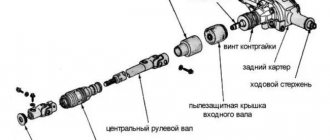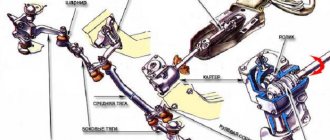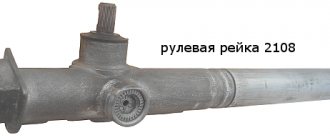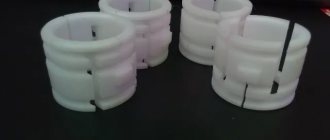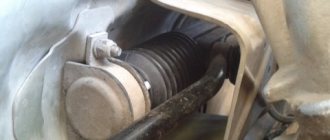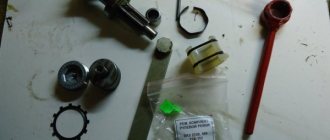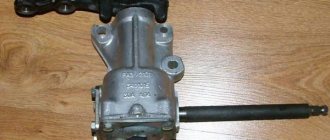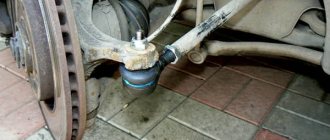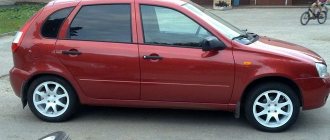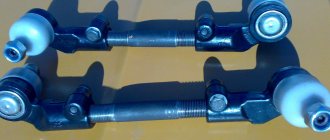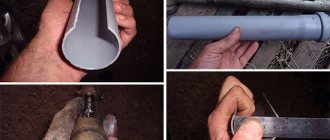Replacing the intermediate shaft of the VAZ driveshaft
As many motorists know, the VAZ 2110 often has such a defect, especially after long-term use, as steering play. In this case, only replacing the steering cardan on a VAZ 2110 helps to establish normal operation. You have to dismantle the column and carry out repairs. Replacing the VAZ 2110 steering cardan, despite its apparent complexity, is an operation that can be carried out on your own.
When and for what reason do you need to change the universal joint?
The crosspiece is a part in itself that is very strong and durable. Theoretically, it is capable of serving for five hundred thousand kilometers of a car. However, in practice the resource is significantly reduced. It depends on the operating conditions of the car, as well as on the quality of manufacture (or rather, on the quality of materials) of the part itself. Most often, the cardan crosspiece has to be replaced or repaired after traveling several tens of thousands of kilometers.
The most common reason why the driveshaft spider will need to be replaced is play in the joint itself. The fact that it has supposedly occurred will be indicated by various extraneous sounds when the cardan rotates: creaking, knocking or metallic ringing, as well as characteristic vibration in certain speed modes or during starting.
Note that all this can be clearly heard in the cabin, so the driver will quickly understand that something is wrong and it’s time to carry out diagnostics. In this case, diagnosis is a very simple operation. True, to carry it out you need an inspection hole, overpass or lift. Next, you need to put the gear in neutral and go down, that is, under the car. Then, holding the cardan cross with one hand, you should try to rotate the cardan shaft with the other. If there is any play, it will be immediately noticeable.
There are usually two reasons for the occurrence of play: wear of the needle bearing or wear of the cross itself. In turn, wear occurs due to leakage or drying of the lubricant in the bearing, exposure to moisture and dust that got there due to the fact that the oil seal was worn out or even flew out.
It is necessary to pay attention to its condition during the purchase and installation of the cross. It would also be a good idea to pay attention to the element during any routine inspection of the car.
Sometimes there may not be obvious play when the bearing wear is not too great. By the way, this malfunction is characterized by specific creaks and squeaks during rotation. In this case, you may not have to change the entire part at once, but just replace the lubricant. How this is done will be described a little later.
Don’t forget about how many crosses there are in the cardan. There are two of them: front and back. Both need to be examined during diagnosis.
Please note, as practice shows, it is the rear cross that wears out more and more often. The fact is that it experiences heavy loads and is more strongly affected by dirt and water.
Results of my work
After driving around, I finally realized that all the problems had been fixed. The replacement itself in the salon would have cost much more, but at home everything cost about one and a half thousand rubles.
This level of repair is not for everyone, although it is not the most difficult; many are afraid of breaking something or putting it together incorrectly; not everyone can be a car mechanic. There are many nuances, as in all car repair operations. But I did it perfectly the first time, so you can try it too, I’m sure that most novice auto mechanics will succeed.
Changing crosspieces in steering cardan shafts
Steering cardan shafts are structural elements of the vehicle control system, which must be given attention in the event of such troubles as:
- difficulty turning the steering wheel;
- steering wheel play;
- knocks and extraneous noises.
There are two elements in the car under consideration. One cardan is located behind the engine shield under the hood of the car. It is adjacent to the steering rack. The second is located in the vehicle interior, or rather, at the driver’s feet. The external driveshaft is subject to more intense impacts because it operates in a harsh environment. However, the internal analogue periodically fails.
To install the parts in question, you must have keys of 10 and 12. During the process, the steering wheel must be fixed and locked in the central position, since without a cardan, turning it can lead to a break in the cable.
After fixing the steering wheel, loosen the boot clamp. Next, the fastening elements of the lower cardan on the rack are unscrewed, as well as the bolt that ensures the connection of the two structural elements in question.
The next step is to dismantle the lower cardan shaft, for which it must be moved sequentially up and down. The upper analogue is simply dismantled. You just need to unscrew the bolt that secures it.
The feasibility of replacing the structural parts of the steering column universal joint is determined by checking the mobility of the bearings and the play of the crosspiece. If critical defects or malfunctions are detected, you will have to purchase a new cardan, crosspiece or bearings, depending on which part has failed.
Why did it happen so?
Perhaps the automatic requests do not belong to you, but to another user accessing the network from the same IP address as you. You need to enter the characters into the form once, after which we will remember you and be able to distinguish you from other users exiting from this IP. In this case, the page with the captcha will not bother you for quite a long time.
You may have add-ons installed in your browser that can make automatic search requests. In this case, we recommend that you disable them.
It is also possible that your computer is infected with a virus program that is using it to collect information. Maybe you should check your system for viruses.
If you have any problems or would like our support team, please use the feedback form.
Replacing the intermediate shaft of the VAZ driveshaft
As many motorists know, the VAZ 2110 often has such a defect, especially after long-term use, as steering play. In this case, only replacing the steering cardan on a VAZ 2110 helps to establish normal operation. You have to dismantle the column and carry out repairs. Replacing the VAZ 2110 steering cardan, despite its apparent complexity, is an operation that can be carried out on your own.
Signs of wear on the crosspiece
Often, motorists do not pay attention to insignificant signs that it is time to make repairs, and wait until the problem makes itself known publicly and this is fraught with consequences, especially when it comes to loss of vehicle controllability.
The first signs of wear on the crosspiece appear as:
- the presence of noticeable resistance to the steering wheel when rotating at speeds above 80 km/h;
- delayed wheel turning and loss of sensitivity (delayed response of wheels and steering shaft);
- increased free play angle of the wheels (popularly this symptom is also called “Steering play”);
- uneven rotation of the steering wheel, the steering wheel moves with sharp jerks;
- obvious grinding or knocking noise that occurs when the steering wheel is rotated; the grinding becomes especially noticeable and obvious on an uneven road.
Most often, motorists turn to a car service center to replace the steering shaft crosspiece mechanism only when the last sign of a malfunction appears, but in vain, because in the event of an emergency, the steering control will not be able to adequately respond to the driver’s efforts, and sometimes, the steering control may even fail, this is already fraught with very big troubles.
Repair of the shaft cross is carried out every 50 - 100 thousand, it is better more often, otherwise it will have to be completely replaced with a new one.
To replace, you will need to purchase a crosspiece - on average 150-300 rubles, some car services claim that for the steering to work correctly, you need the entire steering shaft (4 - 7 thousand rubles), but on most cars it is enough to change only the crosspiece.
Lacetti steering wheel sticks
On the intermediate steering shaft there are two crosses with bearings - one in the passenger compartment, and the second in the engine compartment. As a rule, it is the one under the hood that fails due to environmental influences. At least it is covered with a rubber cover, but this does not solve the problem completely. There is even an opinion that this very cover does not help, but, on the contrary, aggravates the situation, preventing the evaporation of moisture from the cross and, accordingly, it begins to rust and jam. Therefore, some people remove the protective cover completely.
But I think this is a wrong decision. It is better to fill the boot with waterproof lubricant. This, it seems to me, is a better solution to extend the service life of the crosspiece bearings.
1 - lower universal joint; 2 — boot; 3 - seal; 4 - upper cardan joint.
To make the steering wheel easier to rotate for a while, just spray the crosspiece with a can of WD-40, or even better, with a silicone lubricant spray. For example, the one I used to process rubber seals
How to do this without removing the protective cover? Very simple. The cover has a small slot for drainage of condensation, etc. It is located at the bottom and, with the wheels standing level, it is not visible.
You need to turn the steering wheel either to the right or to the left and it will be on top
It is enough to insert a tube from a spray can into this slot and, without sparing, spray lubricant under the cover
After this, turn the steering wheel left and right and let it stand for a while so that the lubricant penetrates where it is needed. As a rule, after this the steering wheel turns without problems.
Useful tips
Finally, here are some useful tips that will extend the life of the steering rack and other elements included in the control unit:
At least once a quarter, check the condition of the steering at a service station or yourself
Pay attention to the condition of the steering column protective cover. Try to limit driving on uneven surfaces, especially at high speeds
Do not test the strength of the steering rack and the entire mechanism by moving away with the steering wheel turned all the way to the side. If play or other signs of steering rack malfunction are detected, repair or replace it.
Dear Drivers, any mechanism in a car does not last forever, so when driving on an uneven road, at one fine moment a knock
which
feeds into the steering wheel
.
Or standing still, there may be a knock when turning the steering wheel
.
These are the first signs that it is time to repair the steering rack
.
The following signs will help you determine the condition of the steering rack:
1.Grip the steering shaft where it meets the rack and move it up and down. If it knocks, then repair the rack housing (most often the reason is that the needle bearing is running without lubrication). 2. You can check the play of the bushing and the contact of the rack with the steering gear by grasping the joint of the steering rods from under the hood.
It’s good if the reason turns out to be poor tightening of the components, but if there is knocking in the rack, then you can do the following: 1. buy a new steering rack 2. restore the steering rack at a service station 3. repair the steering rack yourself
If the price of a new rack does not bother you, then of course it is better to install a new unit. Restoring it at a service station will also cost a pretty penny. Well, the cheapest way to get rid of knocking is to do everything yourself.
What should you know before starting work?
Repair kits are sold to restore the steering rack. The steering rack repair kit can vary in configuration: 1. The minimum set with a washer, bearing, new nut and fluoroplastic bushings costs 250 rubles. 2. A more complete set with bearings and shafts costs about 500 rubles. 3. A complete rack repair kit, which includes the rack itself, will be cost from 850 to 1100 rubles.
In addition, depending on the year of manufacture of the car, the rack may be old (VAZ 2108) or new (VAZ 2110-12). In the latter case, the difference is that you do not need to disassemble the entire mechanism to replace the bushing. It is enough to tighten the corrugation, then unscrew the nut in the middle and the rack is disassembled into two parts (one part is the entire rack mechanism, the second part is where the bushing is located).
The design of the steering rack is as follows. Removing and installing the steering rack on a VAZ 2110. The instructions are clear, except for one point. In order to pull out the shaft, you need a special 24 octahedron key, and there must be a hole inside the key.
If you don’t have such a key, then you can take a long bolt with a 17mm head. Then grind it out of a hex head - almost triangular (one of the edges is slightly sharpened). We sharpen the sides of the bolt to a 10mm wrench. The special wrench for the steering rack is ready!
Steering rack repair kit:
Steering rack assembly:
1.Remove the support sleeve. It is pryed off with a flat screwdriver.
2. Lubricate the place under the support sleeve, and use a screwdriver to put it in place through the hole. To be honest, it’s not easy to install.
3.Cut off the O-rings.
4. Replace the roller bearing. True, it’s better not to touch it, it’s unrealistically difficult to get the old one, at least for me, I couldn’t think of anything better than to chop it into 2-3 parts with a chisel.
5. Replace the bearing on the drive gear shaft.
We insert the rail into the housing and perform assembly in the reverse order, not forgetting to lubricate the parts.
An alternative way to repair a VAZ steering rack (without disassembly).
Main signs indicating a malfunction
It goes without saying that any mechanism sooner or later becomes unusable and fails. Particularly often, the elements of the steering column of the VAZ 2110 wear out after driving on uneven roads and bad roads, which is very important in Russian conditions. When the cardan or other steering component is faulty, a characteristic knock is heard, indicating the need for replacement. Below are the main signs that characterize a malfunction of the driveshaft, and indeed the entire steering gear:
- When the steering shaft is grasped by hand in the area where it connects to the rack and moves up and down, a characteristic knocking sound can be heard.
Note. This knocking sound may not always indicate that the driveshaft has been replaced. It is likely that the needle bearing has failed, which in this case turns out to be without lubrication.
- when there is noticeable play in the bushing and the junction of the rack and pinion.
Often the cause of knocking or play is poor tension of the components, which means doing the following:
- take a wrench or pipe wrench, depending on the situation;
- Tighten any loose bolts and nuts properly.
Replacing steering cardan shafts of a VAZ 2110
If this is not the reason, then either the driveshaft has failed, or you need to buy a new steering rack.
Replacing steering shaft bearings for VAZ 2110 Lada
- Repair manuals
- Repair manual for VAZ 2110 (Lada) 1996+.
- Replacing steering shaft bearings
| EXECUTION ORDER |
↓ Comments ↓1. General information 1.0 General information 1.1. Vehicle Specifications 2. Engine 2.0 Engine 2.1 Possible engine malfunctions. 2.2 Replacing the coolant 2.3 Replacing the engine oil and oil filter 2.4. Installing the piston of the first cylinder to the TDC position of the compression stroke 2.5 Replacing the camshaft drive belt and tension roller 2.6 Adjusting the camshaft drive belt tension 2.7 Removing, troubleshooting and installing the flywheel 2.8. Replacing engine seal parts 2.9 Cylinder head 2.10 Grinding in valves 2.11 Adjusting clearances in valve drive 2.12 Removing and installing engine 2.13. Engine repair 2.14. Lubrication system 2.15. Cooling system 2.16. Exhaust gas system 2.18. Features of VAZ-2112 engine repair 3. Transmission 3.0 Transmission 3.1. Clutch 3.2. Gearbox 3.3. Front wheel drives 4. Chassis 4.0 Chassis 4.1. Checking the technical condition of suspension parts on the car 4.2. Rear suspension 5. Steering 5.0 Steering 5.1 Inspection and check of the steering on the vehicle 5.2. Steering column 5.4. Steering mechanism 5.5 Possible steering malfunctions. 6. Brake system 6.0 Brake system 6.1. Vacuum booster 6.2. Main brake cylinder 6.3. Pressure regulator 6.4. Brake hoses and tubes 6.5 Bleeding the brake system 6.6 Replacing brake fluid 6.7. Front wheel brakes 6.8. Braking mechanisms of the rear wheels 6.9. Parking brake 6.10 Possible malfunctions of the brake system. 7. Electrical equipment 7.0 Electrical equipment 7.1. Mounting block 7.2. Generator 7.3. Starter 7.4. Ignition switch (lock) 7.5. Checking and replacing spark plugs 7.6. Integrated engine management system (fuel injection system) 7.7. Contactless ignition system 7.8. Lighting, light and sound signaling 7.9. Windshield wiper 7.10 Replacing the electric motor of the radiator fan of the cooling system 7.11. Heater electric motor 7.12. Cigarette lighter 7.13. Instrument cluster 7.14 Checking the carburetor solenoid valve control unit 7.15 Possible malfunctions of the EPHH control unit. 7.16 Electrical diagram of a VAZ-21102 car 7.17 Electrical diagram of a car with a carburetor engine 2110 7.18 Engine control diagram 2111 (pin M1.5.4) 7.19 Engine control diagram 2111 (pin MP7.0) 7.20 Control diagram for engines 2111 and 2112 (pin M1) .5.4N, "January-5.1") 8. Body 8.0 Body 8.1 Possible body malfunctions. 8.2. Replacing the buffers 8.3 Removing and installing the radiator trim 8.4 Removing and installing the locker 8.5 Removing and installing the wing 8.6. Hood 8.7 Removing and installing upholstery, trim and windshield frame lining 8.8. Trunk lid 8.9. Side doors 8.10 Removing and installing the front seat 8.11 Removing and installing the upper and lower lining of the floor tunnel 8.12. Seat belts 8.13. Rear view mirrors 8.14. Instrument panel 8.15. Heater 8.16 Anti-corrosion compounds for body treatment 8.17. Features of body repair of models 2111 and 2112 8.18. Body care 9. Applications 9.0 Appendices 9.1 Fuels, lubricants and operating fluids 9.2 Basic data for adjustments and control 9.3 Filling volumes 9.4 Lamps used in the car |
Stories from our readers
“Fucking basin. "
Hi all! My name is Mikhail, now I’ll tell you a story about how I managed to exchange my two-wheeler for a 2010 Camry. It all started with the fact that I began to be wildly irritated by the breakdowns of the two-wheeler, it seemed like nothing serious was broken, but damn it, there were so many little things that really started to irritate me. This is where the idea arose that it was time to change the car to a foreign car. The choice fell on the melting Camry of the tenth years.
Yes, I had matured morally, but financially I just couldn’t handle it. I’ll say right away that I am against loans and taking a car, especially not a new one, on credit is unreasonable. My salary is 24k a month, so collecting 600-700 thousand is almost impossible for me. I started looking for different ways to make money on the Internet. You can’t imagine how many scams there are, what I haven’t tried: sports betting, network marketing, and even the volcano casino, where I successfully lost about 10 thousand ((The only direction in which it seemed to me that I could make money was currency trading on the stock exchange, they call it Forex. But when I started delving into it, I realized that it was very difficult for me. I continued to dig further and came across binary options. The essence is the same as in Forex, but it’s much easier to understand. I started reading forums, studying trading strategies. I tried it on a demo account, then opened a real account. To be honest, I didn’t manage to start earning money right away, until I understood all the mechanics of options, I lost about 3,000 rubles, but as it turned out, it was a precious experience. Now I earn 5-7 thousand rubles a day. I managed to get the car buy after half a year, but in my opinion this is a good result, and it’s not about the car, my life has changed, I naturally quit my job, I have more free time for myself and my family. You’ll laugh, but I work directly on the phone)) If If you want to change your life like me, then here’s what I advise you to do right now: 1. Register on the site 2. Practice on a Demo account (it’s free). 3. As soon as you get something on the Demo account, top up your REAL ACCOUNT and go to REAL MONEY! I also advise you to download the application to your phone, it’s much more convenient to work from your phone. Download here.
The effect after installation is noticeable, but more on small irregularities. That is, when before the steering wheel trembled a little, now this slight trembling is either absent or almost absent. But if you cross the rails, drive along a tractor track, or any other larger irregularity, then I didn’t notice any effect . And the comfort of a foreign car's steering wheel is even further away .
For the sake of experiment, I made 2 videos. I drove the same distance of a couple of hundred meters first before installing the cube, and then after modification. The road is of medium roughness; there are small cracks in the asphalt between the slabs, which appear on the steering wheel both before and after modification. The camera was specially mounted on the steering wheel so that all the vibration was transmitted in the image.
For myself, I concluded that the cube does not remove shaking, but knocks due to gaps in the associated parts.
The road to installing the rubber cube
The road after installing the rubber cube
Good sound insulation is the best way to eliminate car vibrations and vibrations!
Device
As you know, the cardan or intermediate steering shaft, as it is also called, consists of two parts. These are components that are connected to each other by a special universal joint.
VAZ intermediate shaft design
The steering cardan is connected to the drive gear using a special fastener, indicated by the number 9, but this is from the bottom side. But on the top side the cardan rotates in the bracket pipe on ball bearings (there are two of them). As for the main shaft mounts, they are connected to the welded bracket in four places. The front part of the cardan is attached through two plates with special shear heads. And the rear part of the cardan is connected using welded bolts and nuts that have spring washers or, often, self-locking nuts, but without washers.
Replacing steering cardan shafts on a VAZ 2110 upper and lower
Note
It is important to know that depending on the year of manufacture, the steering rack comes in two types. In one case, it is not necessary to disassemble the entire steering rack, but this is mainly for the VAZ 2108 and similar models
As for the steering wheel on the VAZ 2110, to replace the cardan it will need to be disassembled.
To disassemble the rack you need to do the following:
- the protective corrugation is removed;
- the nut located in the middle is unscrewed;
- the rail is disassembled into two parts.
Removing the steering column from a car
VAZ 2110 steering cardan
To replace the driveshaft, you need to remove the steering column from the car. Begin:
- de-energize the battery;
- after that, remove the cover of the signal switch on the steering wheel (to do this, pry it off with a screwdriver);
- remove the cover from the steering wheel;
- Now we are faced with two self-tapping screws, which should be unscrewed with a curly screwdriver;
- after this the lid is completely removed;
Removing the steering wheel cover
- now you need to use the same figured screwdriver to unscrew the three screws that secure the contact of the sound signal;
- disconnect the wire and remove the contact;
- now you will need to take the key for 24;
- use it to unscrew the nut that secures the steering wheel (this should not be done completely, leaving the nut mounted on the shaft);
- remove the steering wheel by pulling it towards you.
Note. The steering wheel should be removed not by jerking, but by rocking the left and right sides and at the same time pulling the part towards you. The nut is not completely removed due to the fact that the steering wheel can come out of the shaft abruptly, thus injuring the face. After removing the steering wheel from the splines, the nut is completely unscrewed.
Advice. If you cannot remove the steering wheel alone, you need to use the help of an assistant who will pull the steering wheel up while the repairman strikes the shaft through a drift.
Removing the steering wheel
- dismantle the steering column switch assembly;
- We also remove the ignition switch;
- take a 13mm wrench and unscrew the bolt securing the elastic coupling (located under the pedals);
- Unscrew the bolts securing the steering shaft at the front.
Note. These fasteners are fixed with bolts with shear heads, which eliminates the possibility of standard unscrewing. To do this, you need to strike with a chisel in a tangential direction.
- now unscrew the nuts securing the steering at the rear, using a 13mm wrench;
- dismantle the steering column of the VAZ.
How to change the crosspiece of a VAZ 2107 quickly
First you need to unscrew the outboard bearing brackets, then thoroughly clean the connection and before unscrewing the flange fixing bolts, you must mark both forks. Chalk, paint, file, whatever, the main thing is not to upset the balance. Disassembly is carried out simply - using a 14-point head, the crosspiece bearings are seated a little deeper than they should be, after which the retaining rings are removed using round pliers. And so four times. After this, the bearings of the fork that is attached to the gearbox flange are knocked out.
Now you can safely change the bearings and the cross itself, having first cleaned the grooves for fixing the retaining rings and carefully lubricated the new bearings with Litol or 158 grease. Assembly is carried out in the reverse order and, as a rule, does not cause any difficulties. Listen to the crosspieces, do not allow the cardan to become unbalanced and have a good trip everyone!
How do you know when it's time to change the driveshaft?
Signs of its malfunction are noticeable, but have little effect on the quality of movement, which is why many car owners ignore the problem until the last moment, almost to the point of losing control of the car. You should not ignore signs of a malfunction; if at least two appear at once, you need to immediately carry out diagnostics. What are the signs of wear or breakage?
- When driving at a speed of more than 80 km/h, the steering wheel resists when turning, making it more difficult to turn.
- The steering wheel turns unevenly and jerks when turning, which puts additional stress on the hands.
- The steering wheel has become less sensitive, and the turning of the wheels responds to control late.
- The appearance of noticeable play (free movement of wheels with stable fixation of the steering wheel).
- Vibration of the driveshaft. Check with a tachometer to see if this vibration appears at one speed or at different speeds. Only vibration at different speeds indicates problems with the cardan; if it occurs at different speeds, but at the same frequency, then you need to think about how to change the steering cardan on a grant, because the speed of the cardan was different at that time.
- Knocking and grinding noises in the steering wheel, especially when driving on rough roads.
Steering shaft SS20 for VAZ (intermediate driveshaft)
In the SS20 steering shaft, instead of needle roller bearings, the cardan uses plain bearings using elastic bushings.
Applicability
- VAZ 2113-2115
- VAZ 2110-2112
- VAZ 1117-1119 (LADA Kalina)
- VAZ 2190-2191 (LADA Granta)
- VAZ 2192, 2194 (LADA Kalina 2)
- Datsun mi-DO, Datsun on-DO
- VAZ 2170-2172 (Lada Priora with EUR)
Advantages of using the SS20 steering shaft in VAZ cars
- silent operation - the universal joint with elastic bushings has no play and therefore does not knock;
- easy rotation and absence of jamming is ensured by the presence of high-quality lubrication and high anti-friction properties of the cardan shaft bushings;
- The elastic bushings of the cardan have sufficient strength, do not wrinkle and have minimal wear, which ensures a long service life.
Guarantee
- Description
- Buy
The intermediate steering shaft (steering cardan) is installed between the power steering (on vehicles with electric power steering) and the steering mechanism. On those cars that do not have a power amplifier, it is installed between the steering column shaft and the steering mechanism, and is designed to transmit force from the rotation of the steering wheel to the steering mechanism.
Since the axes of the steering mechanism and steering column are at an angle to each other, the steering shaft includes a cardan mechanism (one or two, depending on the model), and a rubber damper to reduce vibrations and shocks transmitted to the steering wheel. Cardan mechanism The standard steering shaft installed on the conveyor has four needle bearings in the crosspiece, ensuring free rotation and rotation. During vehicle operation, the needle bearing wears out, increasing the clearance and backlash, which is why knocking, jamming and rolling (uneven rotation) appear. Also, during the production of standard steering shafts, there are defects in the bearings being insufficiently lubricated. Often, there is initially an increased gap in the bearing and from the very beginning of the vehicle’s operation, the steering shaft universal joints are knocking.
The SS20 company offers 2 modifications of steering shafts for each car:
- for the LADA Priora, LADA Kalina and LADA Granta models these are two modifications: the first shaft with an all-welded structure and a modification with a connector in the central part - a shaft of a composite structure.
- for the VAZ 2110 and 2113 models, these are modifications with a rubber damper as in the factory design, and the second modification is an all-welded shaft, from the design of which the damper is excluded;
A shaft with a rubber coupling provides elastic shock absorption from the steering mechanism and standard controllability.
The all-welded shaft and the composite shaft provide more precise and precise vehicle control.
The composite design shaft is easily installed on the car and does not require removal of the steering rack. This eliminates the need to use lifts and other specialized equipment. Installation of a composite shaft on a vehicle can be done on level ground using a minimum set of tools.
In the SS20 steering shaft, instead of needle roller bearings, the cardan uses plain bearings using elastic bushings. This solution ensures preload in each of the cardan joint bearings and, accordingly, the absence of play and the complete absence of knocking in such a joint. Ease of rotation ensures the presence of high-quality lubrication and high anti-friction properties of the bushings.
Diagnostics of the steering propeller shaft
On your car, you can check the serviceability of the steering propeller shaft yourself (note: SS20 steering shafts are installed only on cars with a height-adjustable steering column). To do this, on a car without an EUR:
- Place the car on a flat, horizontal surface with a hard surface.
- With one hand, grasp the intermediate steering shaft in the area of the cardan crosspiece, touching the cardan forks with your fingers.
Diagnostics of the steering shaft for cars with electric power steering is carried out in a similar way, both with the engine running and with the engine not running. It should be taken into account that when the engine is not running, while the steering wheel is rocking, a knock can be heard in the electric power steering - do not confuse it with a knock on the steering shaft (the presence of a knock in the electric power steering when the engine is not running is not a defect).
Steering cardan Structural elements, repair and replacement on the industrial portal Myfta.Ru
When driving, the steering cardan or, as it is also called, the steering shaft is the most common source of uncharacteristic clicks. Experienced mechanics claim that repairing this mechanism is not a very difficult procedure, since it is only one small part. True, his drawing consists of several elements, to be precise.
Among these elements are:
- mounting bracket;
- bipod shaft;
- steering mount intermediate shaft
- fasteners;
- steering cardan crosspiece.
When such a mechanism breaks down, car owners are faced with a dilemma: choose to repair the faulty element or buy a new one, so as not to constantly have to worry about repairs. In fact, both repairs and balancing can be reliable if you turn to specialists.
The steering rack cardan (sometimes also called a gearbox) is the power unit of the steering mechanism, which serves to transmit forces to the steered wheels from the steering column. Quite consistently, the forces exerted by the driver using the steering wheel are distributed to the steering column, after which, thanks to tips and rods, through the steering axles, they are transmitted to the steering arms, which are connected to the steering wheels.
Sometimes it may be necessary to restore the steering rack, which involves complex work aimed not only at cleaning the part from contamination, but also at replacing some spare parts with new ones. By the way, sometimes mechanics simply restore factory parts. Restoration involves the complete restoration of the original performance of the steering cardan.
It is noted that the steering rack is an incredibly important part of any car. If somehow it turns out that it is faulty, then not only safety, but also the lives of passengers and the driver of the car may be in danger
Experts recommend approaching the repair of this part with great responsibility, and also carry out diagnostics at least once every six months.
How to replace the steering shaft crosspiece - why change it and the replacement procedure
Hello, dear car enthusiasts! The steering of a car is not only a set of parts and mechanisms that allow you to set the direction of movement required by the driver, but to a greater extent a unit responsible for the safety of everyone in the cabin.
Steering malfunctions very often become the causes of serious accidents, in which other road users may suffer in addition to you (God forbid).
A good driver always reacts to the slightest changes in the operation of the car’s mechanisms, and if the controls fail, the reaction should be immediate.
When expressing your suspicions about a steering failure, you can often hear the phrase from a car service specialist: the steering shaft crosspiece is faulty. Such a malfunction is easy to diagnose and fix yourself.
Purpose and design of the steering shaft crosspiece
Replacing the cross
Everyone who is familiar with the structure of the VAZ “classic” knows that the steering shaft is connected directly to the worm shaft and there are no other joints in this design.
Newer car models have such a design of the chassis and body that the steering shaft must have a downward angle in a certain place. The crosspiece of the steering shaft is precisely designed to transmit torque from a section of the shaft in the cabin to a section of the shaft or gear of the rack and pinion mechanism (worm) in the engine compartment.
The steering shafts of some domestic and imported cars even have two crosses. This was done to allow the steering wheel to be adjusted in height.
In principle, the design of the cross is very simple. The crosspiece itself is made of durable steel with four spikes onto which the needle bearing cages are mounted. The clips themselves are inserted into the bracket (fork), which is connected to the splined ends of the shafts. The bearings have seals made of oil-resistant rubber.
When is it necessary to replace the steering shaft crosspiece?
The following signs may indicate that you need to pay attention to the condition of the steering cross bearings:
- excessive effort must be made to rotate the steering wheel;
- an increase in the free play angle of the steering wheel or delayed response of the wheels when turning the steering wheel;
- uneven rotation of the steering wheel, jerking, “biting”;
- extraneous knocking, grinding, noise when maneuvering and overcoming uneven sections of the road.
The fact is that the universal joint, especially the one located in the engine compartment, is constantly subject to negative influences: vibration, temperature changes, friction, high humidity.
All this over time leads to loss of elasticity and loss of rubber seals. Leaked and dried grease provides a large field of activity for dust and moisture. Bearing needles very quickly become corroded and wear out.
Procedure for replacing the steering shaft crosspiece
Repair of the crosspiece, in essence, is not carried out (!) This is a pointless matter. The repair consists of replacing the old cross with a new one along with all the bearings. Crosspieces are offered for sale in just such a set.
The steering shaft crosspiece can be removed quite simply using the following algorithm:
- the steering shaft is installed in such a way as to provide access to the bolts that compress the upper and lower casing of the crosspiece forks;
- the bolts on the upper and lower forks must be completely unscrewed and removed;
- moving the cross block along the splines, first remove it from one end of the shaft, and then from the other (sometimes you will have to remove the steering column to do this, which is also useful for checking the condition of the bearing).
Bearing races, as a rule, are secured by punching, which can be easily eliminated using a small chisel or drill with a thin drill bit. Then the clips are pressed out one by one in a vice.
Assembly of the unit occurs in the reverse order, but it is important to remember that the bearing races are pressed into the forks only from the outside until completely immersed. Don’t forget to apply a new core to fix the bearings
And, thus, the repair of the steering shaft crosspiece can be considered complete.
Differences between a short-stroke link
The main differences can be seen even in photographs. We see that the short-stroke rocker has smaller dimensions, namely length. To reduce the stroke length at startup, the length of the transmission under the hinge should be increased. Due to this, we can not only get shorter gears, but also maintain the traction axis in its original position.
The photo shows a self-modernized backstage. As an alternative, you can use a part from other VAZ models.
It is worth understanding that after such tuning, you will need to put more effort when changing speeds. After upgrading, switching will resemble joystick control, which is undoubtedly a plus. In addition to the rocker, you can install a backlash-free cardan, which will also have a positive effect on the smooth operation of the gearbox.
The replacement takes place in several stages:
- We lift the car off the ground using a lift or by rolling it into a hole, but you can also get by by lifting the front of the car.
- We set the steering wheel at a right angle and fix it, and also fix the steering wheel; during replacement, movement of the wheels and steering wheel is not desirable.
- To access the steering shaft, remove the left (right) wheel. We go into the salon and unscrew the fastening bolt; after a slight effort, the steering shaft should come off the steering wheel.
- Under the car, carefully remove the upper and lower casings, check the amount of dirt on the crosspiece and steering shaft driveshaft; not all cars have them protected by a boot (purchase and installation of such rubber will cost 100-200 rubles).
- We find and unscrew the bolt on the crosspiece; you may have to use a WD tool. Once the bolt is removed, the steering shaft should easily come off the steering rack.
- Pull the shaft down and pull it out. Often the crosspiece mechanism is rusty and dirty; first of all, you will need to wash it.
- For flaring you will need a sprocket of the appropriate diameter; fix the shaft in a vice.
- Using a head (presumably a 8-pointer), we knock out the cross first in one direction (remove the bearing cup), and in the other direction (also remove the cup).
- Then we take a new crosspiece and insert it in the same order - we start one side first, and then the other, press it in using a vice (but not too tightly, the metal may wrinkle).
- We align both cups and roll them with a chisel and hammer.
The final assembly procedure is no different from disassembly - the main thing is to maintain order. So, we have replaced the steering shaft crosspiece; if everything is done correctly, the handling will respond better to your efforts.
